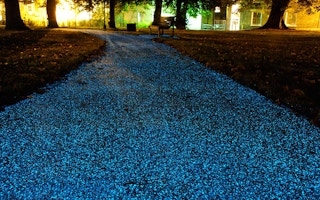British firm Pro-Teq Surfacing has paved the way for a new type of sustainable lighting source in the United Kingdom, creating a spray-on coating that allows pathways and like surfaces to capture energy during the day for use at night.
To continue reading, subscribe to Eco‑Business.
There's something for everyone. We offer a range of subscription plans.
- Access our stories and receive our Insights Weekly newsletter with the free EB Member plan.
- Unlock unlimited access to our content and archive with EB Circle.
- Publish your content with EB Premium.
This patented re-surfacing technology, called Starpath, is a liquid-based product mixed with natural earth aggregate material. It is the result of an extensive trial period refining the chemistry behind the particles that absorb ultraviolet (UV) rays, which then enable the coated surface – whether concrete, tarmac, timber or other solid forms – to glow.
The firm has currently applied this non-slip, water-resistant coating technology at a 150-square-metre pathway in Christ’s Pieces, a park near the centre of Cambridge. Without any need for electricity, this is the world’s first self-powered sustainable path.
The renewed road serves as an alternative to street lighting and it also minimises the city’s carbon footprint, Pro-Teq noted.
“
This product adjusts to the natural light, so if it is pitch black outside, the luminous natural earth enhances, and if the sky is lighter, it won’t release as much luminosity – it adjusts accordingly
Hamish Scott, Pro-Teq owner
Hamish Scott, Pro-Teq Surfacing owner, said: “This product adjusts to the natural light, so if it is pitch black outside, the luminous natural earth enhances, and if the sky is lighter, it won’t release as much luminosity – it adjusts accordingly.”
In addition to this energy-producing feature, the Starpath extends the life cycle of existing paths and lanes, as it is a re-surfacing technique, Pro-Teq explained. This means there is no need to remove and replace the current surface, doing away with consuming unnecessary energy and resources for such. The Starpath spray-on coating, instead, gives it a new layer and sheen, complete with a protective top layer for longevity.
All it takes is a quick application. For example, 30 minutes of spraying for the Cambridge path, said the firm, and it was ready for use less than four hours after the job was started. There is hardly any disruption to public use and it makes it labour-efficient for clients and organisations, emphasised Pro-Teq.
“Councils spend significant sums of money fully replacing existing pathways when the existing surfaces have reached the end of their practical life. Our product is cost effective, fast to apply and fast to set,” Scott said.
There are also different colours and size of aggregates to choose from, he added.
Once installed, the non-slip and non-reflective properties of the Starpath help lessen the risk of accidents and collisions, especially among cyclists and pedestrians.
Neil Blackmore, Pro-Teq sales director, said: “We found a niche in the market, really, where lots of councils now are cutting power in the evening so the pathway network, therefore, can’t be seen. Now, Pro-Teq is establishing where the pathways are for the users, making it safer for everyone.”
Earlier in the year, London mayor Boris Johnson announced a £913 million 10-year plan to make the capital safer for cyclists.
Meanwhile, UK charity Sustans, which has a National Cycle Network covering over 22,500 kilometres, also aims to have better cycling and walking links, to ultimately encourage more sustainable local travel by 2020.










